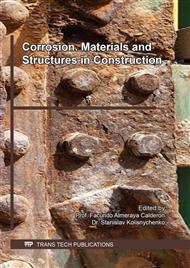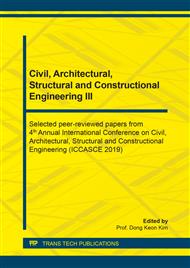[1]
Al-Emrani, M. and R. Kliger, Analysis of interfacial shear stresses in beams strengthened with bonded prestressed laminates. Composites Part B: Engineering, 2006. 37(4): pp.265-272.
DOI: 10.1016/j.compositesb.2006.01.004
Google Scholar
[2]
Sugimoto, I., Y. Kobayashi, and A. Ichikawa, Durability evaluation based on buckling characteristics of corroded steel deck girders. Quarterly Report of RTRI, 2006. 47(3): pp.150-155.
DOI: 10.2219/rtriqr.47.150
Google Scholar
[3]
Long Bien bridge. Great National Unity, 2015.( http://daidoanket.vn/kinh-te/bo-tri-von-khoi-phuc-cau-long-bien-tintuc69677).
Google Scholar
[4]
Ham Rong bridge. Vietnamese National Times, 2015.( http://toquoc.vn/thanh-hoa-cai-tao-sua-chua-cac-tuyen-duong-tai-khu-di-tich-lich-su-van-hoa-ham-rong-99200001.htm).
Google Scholar
[5]
Kaita, T., et al., Analytical study on remaining compressive strength and ultimate behaviors for locally-corroded flanges. Proc. of EASEC-11, Taiwan, (2008).
Google Scholar
[6]
Appuhamy, J., et al., Prediction of residual strength of corroded tensile steel plates. International Journal of Steel Structures, 2011. 11(1): pp.65-79.
DOI: 10.1007/s13296-011-1006-6
Google Scholar
[7]
Appuhamy, J.R.S., et al., Reduction of Ultimate Strength due to Corrosion-A Finite Element Computational Method. International Journal of Engineering (IJE), 2011. 5(2): p.194.
Google Scholar
[8]
Kaita, T., et al., Experimental study on remaining strength estimation of corroded wide steel plates under tensile force. 2011. 14: pp.2707-2713.
DOI: 10.1016/j.proeng.2011.07.340
Google Scholar
[9]
Kania, R. and L.B. Carroll. Non-Destructive Techniques for Measurement and Assessment of Corrosion Damage on Pipelines. in 1998 2nd International Pipeline Conference. 1998. American Society of Mechanical Engineers.
DOI: 10.1115/ipc1998-2037
Google Scholar
[10]
Rowe, L., Measurement and evaluation of pitting corrosion, in Galvanic and Pitting Corrosion—Field and Laboratory Studies. 1976, ASTM International.
DOI: 10.1520/stp41406s
Google Scholar
[11]
Velázquez, J., et al., Predictive model for pitting corrosion in buried oil and gas pipelines. 2009. 65(5): pp.332-342.
DOI: 10.5006/1.3319138
Google Scholar
[12]
Kulicki, J., et al., Guidelines for evaluating corrosion effects in existing steel bridges. (1990).
Google Scholar
[13]
Aliofkhazraei, M., Developments in Corrosion Protection. 2014: IntechOpen.
Google Scholar
[14]
Cosham, A., P. Hopkins, and K.A. Macdonald, Best practice for the assessment of defects in pipelines – Corrosion. Engineering Failure Analysis, 2007. 14(7): pp.1245-1265.
DOI: 10.1016/j.engfailanal.2006.11.035
Google Scholar
[15]
Saad-Eldeen, S., Y. Garbatov, and C.G. Soares, Effect of corrosion degradation on ultimate strength of steel box girders. Corrosion Engineering, Science and Technology, 2012. 47(4): pp.272-283.
DOI: 10.1179/1743278212y.0000000005
Google Scholar
[16]
Record, S.J., The mechanical properties of wood: including a discussion of the factors affecting the mechanical properties, and methods of timber testing. 1914: J. Wiley & Sons, Incorporated.
Google Scholar



